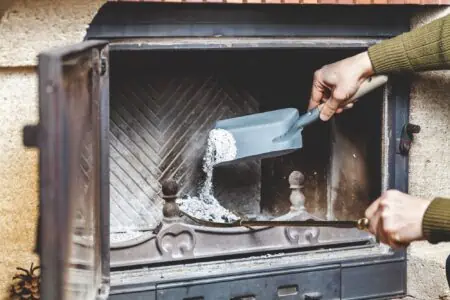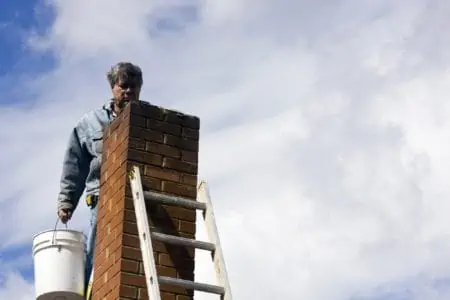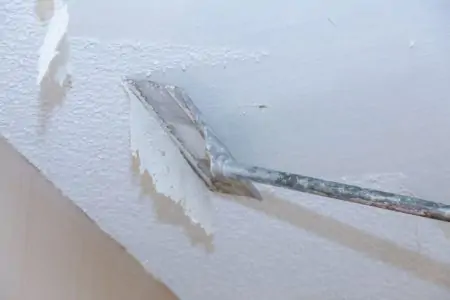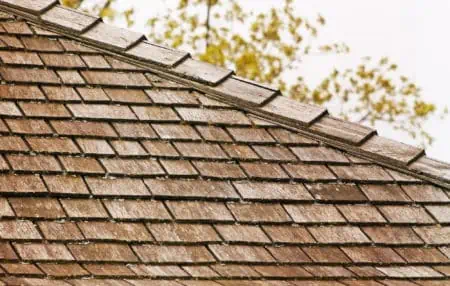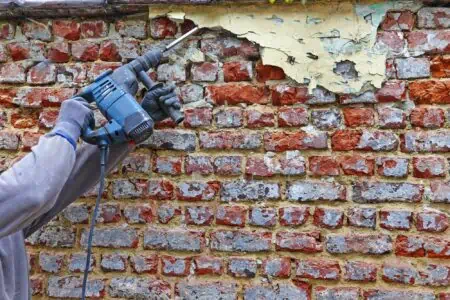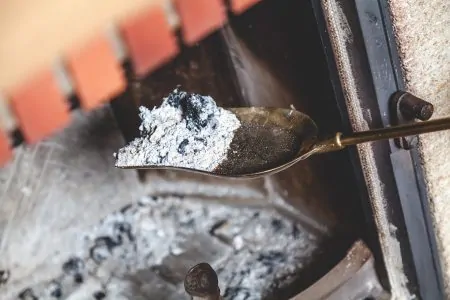Having a fireplace in your home is a real luxury. But it’s also high maintenance. If you don’t keep it clean, it can become a fire hazard, putting you at risk.
Since there are no instructions on how to clean a fireplace attached to the mantelpiece, you have to look elsewhere. That’s where we come in. After having a fireplace for many years, we have a fireproof method to share with you.
We’ve got methods for both a wood-burning fireplace and gas. Keep reading for our step-by-step guide for cleaning ash, the firebox, door, grates, accessories, and tools.
Key Takeaways
- Clean wood-burning fireplaces weekly and gas fireplaces monthly; remove ash, dust, and soot.
- Prevent creosote buildup, a fire hazard and health risk, by cleaning your chimney at least once a year.
- To clean a wood-burning fireplace, use a mixture of baking soda, water, and dish soap to scrub the firebox and rinse with water.
- For gas fireplaces, turn off the gas, disassemble, and clean components with a soft-bristled brush, vacuum, and vinegar solution.
When to Clean a Fireplace
Experts recommend that you sweep and shovel a wood-burning fireplace weekly. You should dust gas and electric fireplaces every week, too. This is if you use the fireplace frequently — if you only use it occasionally, once or twice a month is fine.
This weekly cleaning should include the firebox, the surround, the doors, andirons (the bar that holds the logs), and grates.
It’s recommended that you clean your chimney, vents, and flues at least once a year. The best time to do this is when the weather becomes cold, usually around mid to late autumn.
Hazard
You should only clean your fireplace once the logs and ashes have cooled. This can take hours, so we recommend waiting at least 12, if not 24, before cleaning.
What is Creosote?
One big reason to regularly clean your fireplace is because of the creosote buildup. Creosote is a byproduct of burning wood that lingers in your chimney until it’s cleaned.
After burning wood, the creosote is a flaky substance that you can brush away. But if you don’t clean it, it becomes a sticky substance that is hard to clean. Afterward, it hardens, making it challenging to remove.
Once it’s hardened and you use your fireplace again, the creosote can drip down like candle wax. This is very dangerous to breathe in — and if you do so regularly, you can develop respiratory abnormalities and even cancer (1).
It’s also carcinogenic through long-term exposure to your skin. So you must stay protected while cleaning creosote from your fireplace.
Another risk of creosote is that it’s a fire hazard. The creosote deposits are flammable and can reignite when they come into contact with a burning fire.
How to Clean Ash From a Fireplace
Once a week, you should clean the ash, dust, and soot from your fireplace. However, leaving about an inch of ash is important to help insulate the embers and keep them burning well. That’s why we don’t recommend doing this after every use.
- Time: 15 minutes.
- Difficulty: Easy.
What You’ll Need
- Old cardboard or newspaper.
- Protective gloves.
- Fireplace shovel.
- Metal bucket.
- Fireplace broom.
1. Protect the Area and Yourself
Remove rugs from nearby the fireplace. Lay down protective layers directly in front of the fireplace, such as old cardboard boxes or newspapers. Don your protective gloves to shield your skin.
2. Remove the Grate
If your fireplace has a removable grate, take it out now. This gives you easier access to the ashes.
3. Shovel Out the Ashes
Use your fireplace shovel to remove the ashes. Place them into your metal bucket. We’re using metal because sometimes the ashes can still be hot — this will prevent them from melting a plastic bucket.
Continue until you’ve removed most of the ashes. If you plan to use the fireplace again soon, don’t forget to leave a one-inch layer of ash. If you’re not going to use your fireplace again for a while, remove all the ashes.
4. Sweep the Soot
Use your fireplace shovel to sweep excess ashes to one corner. Then use your shovel to remove them and place them in the bucket.
5. Tidy
Return the grate to the fireplace. Pour any ash that has fallen on your cardboard or newspaper into the metal bucket.
Use your fireplace broom to sweep excess soot that’s fallen onto the floor. Push it into the shovel and empty it into the bucket. You might want to mop the floors later.
Take the ash bucket outside to a dry spot and let it sit for a couple more days. You want it to be 100 percent cool. Once it’s cooled, discard it in your residual waste.
How to Clean a Wood-Burning Fireplace
It’s important to deep clean your fireplace once a week for regular use or monthly for more infrequent uses. We’ll walk you through how to clean a fireplace, firebox, doors, grates, accessories, and tools. We know that this is quite time-consuming, but it’s vital to the safe use of your fireplace.
Remember to sweep the fireplace before diving into these methods. You don’t want there to be any soot or ash in the firebox before starting.
Grab your cleaning kit, and let’s go!
- Time: Two hours.
- Difficulty: Intermediate.
What You’ll Need
- Spray bottle.
- Shop vac or old vacuum cleaner.
- Protective gloves.
- Newspapers or paper bags.
- Wire brush scraper.
- Bucket.
- Bristled brush.
- Warm water.
- Baking soda.
- Cloth or rag.
- Dish soap.
- Garden hose (optional).
- Towels.
Firebox
- Remove all soot: Even though you’ve already removed most of the soot, you’ll need to remove it completely to deep clean the box. The best way to do this is by vacuuming it with a shop vac or an old vacuum. We say old vacuum because the ash can damage your brand-new vacuum.
- Scrape the box: Lay down newspaper or paper bags on the firebox floor. Start scraping the firebox with your wire brush scraper to remove soot and debris.
- Prepare solution: Fill a bucket with a 1:1 solution of baking soda and water. Start with two cups of baking soda per two cups of warm water and increase quantities as you go to prevent waste. Add a few drops of dish soap for extra cleaning power.
- Apply the solution: After mixing the solution well, dip a bristled brush into the solution. Apply it to the firebox walls, scrubbing hard to remove stains and buildup. Continue until you’ve applied it to every area of the firebox.
- Rinse: Empty the bucket and refill it with warm water. Rinse off your bristled brush and dip it into the plain water. Apply it to the fireplace’s walls to rinse off the baking soda and soap residue.
- Wipe: Dampen a cloth or rag in plain water and wipe down the firebox. Let it fully air dry before you use it again.
If you have a metal insert fireplace, you should be able to use the same cleaning method. But check with your supplier first.
Doors and Grates
- Wipe: Dampen a cloth or rag in plain water and wipe the top layer of burnt ash off the glass doors.
- Add ash: Sprinkle a little ash from your metal bucket onto a dampened cloth.
- Wipe again: Wipe the glass doors again with the ashy cloth. The abrasiveness from the ash will help to break down soot and stains. Continue until the doors are cleaned. Swap out for a new clean cloth when necessary.
- Buff: Use a clean, dry cloth or rag to buff out the glass door and remove ashy residue.
- Sweep the grates: To clean the grates, start by taking them outside. Over your metal bucket, sweep the ash off using your bristled brush.
- Make solution: In a separate bucket, combine warm water and a few squirts of dish soap.
- Clean: Dip your bristled brush in the solution and apply it to the grates. Scrub well until the soap suds up.
- Rinse and dry: Rinse the grates by submerging them in a bucket of clean water or spraying with your garden hose. Dry using a towel, then leave to air dry until your fireplace is fully clean.
Accessories and Tools
It’s important to regularly clean your fireplace, shovel, broom, and other tools. Most are made from cast iron, so this is the best cleaning method for those:
- Dampen: Take the tools outside and hose them down or spritz them generously with water.
- Apply baking soda: Apply a generous layer of baking soda over the dampened tools.
- Scrub: Use your bristled brush to scrub the tools well, working the baking soda over the metal. This will help to remove soot, ash, and other buildups.
- Rinse: Once the tools are noticeably cleaner, rinse them down again. Use your garden hose or a soaking wet towel to remove baking soda residue.
- Dry: Use a separate towel to dry the tools. Then leave them to further air dry before using them again.
How to Clean a Brick Fireplace
Keep the brick around your fireplace clean to prevent soot buildup and stains. You should also carry out this method before painting so that you have a clean area to work with.
- Vacuum: Use the soft brush attachment on your vacuum to remove dirt and debris from the brick.
- Prepare a paste: Mix together equal parts dish soap and table salt to create a paste.
- Spritz the bricks: Fill a spray bottle with water and dampen the bricks. A generous helping will prevent the bricks from absorbing excess paste. Work in a small area at a time, so the water doesn’t dry into the brick.
- Apply the paste: Start at the top of the brick and work your way down. Dampen a cloth and apply the paste to the dampened brick.
- Scrub: Use a nylon-bristled brush to scrub the paste into the brickwork. Work hard to remove stains and dirt.
- Rinse: Spray the area with water again and wipe off the cleaning solution before it trickles down.
- Repeat: Repeat on each section of the fireplace.
- Air dry: Leave the bricks to air dry.
Caution
If you have fireplace tiles made from a different material, don’t use this method. Check with the manufacturer before cleaning.
How to Clean a Gas Fireplace
Cleaning a gas fireplace is very different from cleaning a traditional fireplace. But these fireplaces are popular, so we must teach you the best method.
- Time: 40 minutes.
- Difficulty: Intermediate.
What You’ll Need
- Soft-bristled brush or hand broom.
- Vacuum cleaner with brush attachment.
- Cheesecloth or nylon net (optional).
- Cloths.
- Spray bottle.
- Distilled white vinegar.
- Water.
1. Turn Off the Gas
Before you get started, turn off the gas fireplace. Ensure the gas valve and electricity are off for at least one hour before you start cleaning. Wait for the fireplace to cool down thoroughly.
2. Disassemble the Fireplace
Read your user manual for the best instructions on removing the glass, logs, and burner. Make sure to take pictures along the way, so you know exactly how to replace the logs later.
3. Brush the Logs
Use a soft-bristled brush to gently wipe down the logs and other components you’ve removed. Get into all the nooks and crannies.
While at it, dust the burner unit and each vent hole inside the fireplace.
4. Vacuum
Place the brush attachment to your vacuum cleaner and gently move around inside the fireplace to collect debris. Get into all corners.
If your gas fireplace uses rocks, be careful not to suck up the rocks. To prevent this, you can place a nylon net or cheesecloth over the vacuum nozzle.
5. Wipe the Pilot Light
Use an old rag or cloth to wipe the firebox’s pilot light and gas line components.
6. Clean the Glass Door
Make a 1:1 solution of white vinegar and water in a spray bottle. Spray the glass door inside and out. Let it sit for a few minutes.
Wipe the glass door with a soft cloth. Dampen the cloth and clean around the door, including any rubber gaskets.
Warning
Don’t use ammonia-based glass cleaners or an oven cleaner on a gas fireplace. It’s a fire hazard. If you want to use a store-bought product instead of vinegar, we recommend Rutland White Off.
7. Dust the Area
Use a soft cloth to dust the mantle, hearth, and fireplace exterior.
8. Reassemble
Put the logs, burner, and glass back into the firebox. Make sure everything is in the right place. Once done, it’s safe to turn the gas back on.
Professional Fireplace Cleaning
There’s a time and place for professionals to clean your fireplace.
For starters, you should hire a professional to clean your chimney. A chimney sweep can safely and effectively clean inside, removing creosote, animals, and any other foreign objects that pose a threat. It’s vital to hire somebody to do this once or twice a year.
We recommend hiring somebody to clean your fireplace at the end of summer, just before you start using it again. Who knows what’s been festering in there all summer long?
Another reason you might want to hire a professional is if you’re worried about the mess. They have special tools to create a minimal mess.
A professional can also spot safety hazards and other problems within your fireplace. If you’re worried about your fireplace’s safety, notice strange odors, or can’t seem to get your fireplace clean, call a professional.
Depending on where you live and how extreme the job is, the price can range from about $120 to $400. The national average is $252 (2).
Fireplace Maintenance Tips
Now that you know how to clean the inside of a fireplace and the brickwork, you’re well prepared. But there are some things you can do outside of the regular cleaning routine to maintain your fireplace. Here are our top tips:
- Your wood choice: We recommend seasoned hardwood like oak and birch. Avoid softwood, such as cedar and pine, which can contain more moisture. You should be sure that the wood has been dried for around 12 months before burning.
- Test before use: Light just a few pieces of wood if it’s been a while since you used your fireplace. Check that the smoke comes out of the chimney. If it comes into the room instead, you will need to fix the issue — there may be an obstruction or creosote buildup.
- Look out for issues: If you notice anything awry with your fireplace, don’t ignore it. This could include smoke filling the room, white stains on the brickwork, rust, or spalling bricks. Call a professional if necessary.
- Stay safe: Move combustible furniture and rugs away from the fireplace. Don’t leave a fire unattended. Keep a fire extinguisher nearby.
- Fill gaps in the brickwork: If you notice gaps in the brick mortar, this can cause the fireplace to expand and contract. Make sure these are filled in with a mineral-based filler or caulk.
- Replace the fireplace screen: If you’re not using a fireplace screen already, get one. It’s the best way to prevent embers and ash from bouncing into your living space. From time to time, make sure to replace yours so that it works to the best of its ability.
- Clean glass regularly: No matter if you have a wood-burning or gas fireplace, cleaning the glass is essential. It’s important that you can see what’s going on in the firebox to ensure nothing hazardous is happening.
- Replace the batteries: For a gas fireplace, make sure that you replace the batteries in your fireplace remotes. If you need to turn off your gas fireplace quickly, the last thing you need is for the batteries to die suddenly.
- Clean airflow and louvers: In gas fireplaces, use a soft microfiber cloth to wipe the airflow and louvers. This will remove dust and dirt buildup. If you don’t have louvers, inspect the air cavities for obstructions or dust buildup.
FAQs
Don’t Play With Fire
When you are the proud owner of a fireplace, it’s vital that you prioritize safety. Don’t neglect cleaning a fireplace, and don’t take any risks.
Make sure to clean soot and ash from your fireplace every few uses. Once a week or once a month — depending on how often you use your fireplace — issue a deep clean.
Once or twice a year, hire a professional to deep clean your fireplace and chimney. Staying on top of these chores can prevent a fire in your home.
